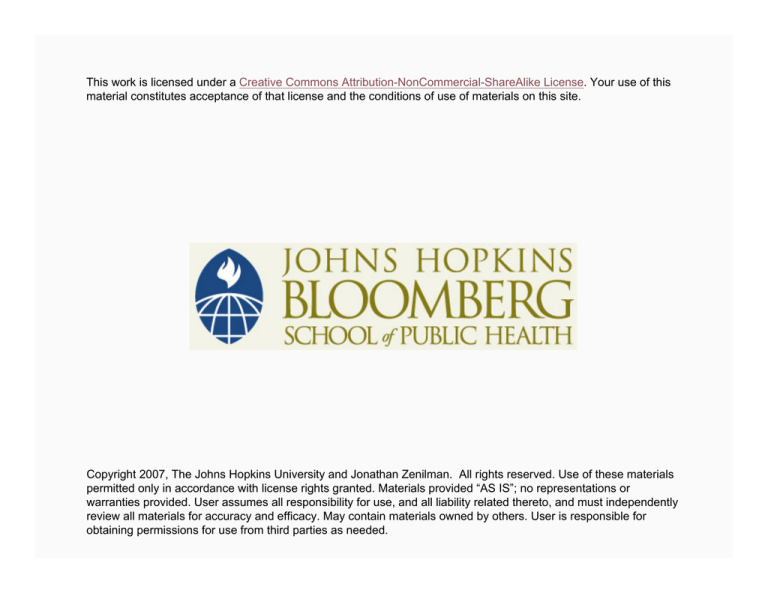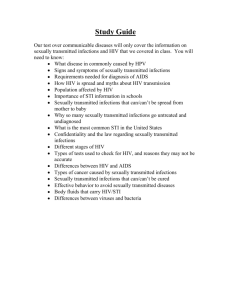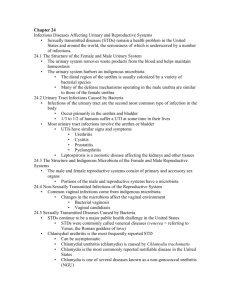
This work is licensed under a Creative Commons Attribution-NonCommercial-ShareAlike License. Your use of this
material constitutes acceptance of that license and the conditions of use of materials on this site.
Copyright 2007, The Johns Hopkins University and Jonathan Zenilman. All rights reserved. Use of these materials
permitted only in accordance with license rights granted. Materials provided “AS IS”; no representations or
warranties provided. User assumes all responsibility for use, and all liability related thereto, and must independently
review all materials for accuracy and efficacy. May contain materials owned by others. User is responsible for
obtaining permissions for use from third parties as needed.
An Introduction to STI Policy and Programming
Christina Schumacher, MHS
Keri Althoff, MPH
Johns Hopkins University
Overview
Basics of policy and program
An approach to problem solving
Communication of policy and program
Important: You need to have read the Lancet article by Glasier et
al. (2006) to receive full benefit of this lecture in helping you
prepare for your project.
3
Objectives
Identify an STI problem/issue
Develop a policy or program recommendation to address the
problem/issue
Demonstrate the skills necessary to communicate the
recommendation to a policy maker
4
Section A
Basics of Policy and Program; Problem Definition
Simple Problem Identification
What is happening?
What should be happening?
Is there a difference?
Is the difference significant?
If the answer to these questions is “YES,” write a problem
statement
6
Basics of Policy and Program
What is a policy?
What are examples of policies?
7
Basics of Policy and Program
What is a policy?
“a philosophical course of action that defines priorities,
articulated or adopted by a policy-making body, such as a
municipal, state, or national government, or an established
group of experts, or a group of organizations bound under a
commonality, etc.”
— Dictionary.com with revision by your TAs
What are examples of policies?
8
Basics of Policy and Program
Example of a policy
− On January 22, 2001, President George W. Bush announced
reinstatement of the so-called Mexico City policy that required
non-governmental organizations to "agree as a condition of their
receipt of Federal funds that such organizations would neither
perform nor actively promote abortion as a method of family
planning in other nations"
9
Basics of Policy and Program
Result of this policy
− Implementation of this policy resulted in making many nongovernmental organizations (NGOs) which performed safe
abortions ineligible for any Federal assistance funds from the
U.S., regardless of the source of funding for abortions
10
Basics of Policy and Program
What policies were mentioned in Glasier et al.?
11
Basics of Policy and Program
What is a program?
“a plan of action to accomplish a specified goal”
— Dictionary.com with revision by your TAs
What are examples of programs?
12
Basics of Policy and Program—Example
Example of a program
− In 2002, to comply with a policy aimed at reducing the burden
of STIs among Philadelphia youth, the Public Health Department
implemented gonorrhea and chlamydia screening in public high
schools
13
Basics of Policy and Program
What programs were mentioned in Glasier et al.?
14
Basics of Policy and Program—Differences/Similarities
What are the differences and similarities of policy and program?
− Many more similarities than differences
− Policy is a philosophical course of action articulated or
adopted by a body
− Program is a plan of action to accomplish a specified goal
15
An Approach to Problem Solving
1.
2.
3.
4.
Creating a problem definition
Identifying stakeholders
Identifying policy or program options to solve the problem
Recommending a course of action
16
1. Problem Definition
“A problem well stated is a problem half solved”
— John Dewey
Defining a problem is an iterative process and will be the most
difficult (but most rewarding) part of this project!
17
1. Problem Definition—Key Aspects
Key aspects of a problem definition
− Specificity of the problem
− Nature of the problem/focus
− Framing of the problem
X Population
X Context
X Time frame
− Causality
− Language considerations
− Dos and don’ts
18
1. Problem Definition—Specificity
Specificity of the problem
− What is the specific dimension or aspect of interest?
− If you think you are being too specific, you probably are not
− Avoid broad, general topics
19
1. Problem Definition—Nature of the Problem/Focus
Nature of the problem/focus
− Is this an STI-focused public health problem?
− If you are too broad, your problem might begin to cross the line
into other fields, such as economic or political problems
− Not all health problems are public health problems
X The difference between clinical patient management and
public health
20
1. Problem Definition—Population
Framing of the problem: population
− Who is affected by this problem?
− Be as specific as possible
X Gender
X Age
X Nationality
X Race/ethnicity
X Sexual orientation
X Injection drug users (IDU)
X Housing situation
21
1. Problem Definition—Context
Framing of the problem: context
− What is the context? Where is the problem located?
− Be as specific as possible
X Geographical
X Cultural
X Social
X Political
X Economic
X Historical
X Ethnic
22
1. Problem Definition—Time Frame
Framing of the problem: time frame
− What is the specific time frame
− Be as specific as possible
X Dates (1990–1991)
X Time since a specific event (post 9/11)
23
1. Problem Definition—Causality
Causality
− Are etiologic factors or causes part of your problem statement?
− AVOID causal claims—there are implications of including causal
claims in your problem statement
24
1. Problem Definition—Language
Language considerations
− Be clear and precise
− Define and reference technical terms
− Define local terms
− Make sure it is a statement (grammar, sentence structure, etc.)
25
1. Problem Definition—Dos and Don’ts
Dos and don’ts in a problem definition
− Don’t state the definition of a topic (as opposed to a problem)
− Do be clear in defining the population or sub-population
− Don’t suggest a solution in the problem statement
− Don’t mention key determinants or make causal claims in the
problem statement
26
1. Problem Definition
Let’s practice . . .
“Unsafe sex is the second most important risk factor leading
to disability or death in the poorest communities and ninth
most important in developing countries.”
— From Glasier, (p. 1595)
Based on what we just learned about problem definitions, what is
your critique of these problem definitions?
27
Section B
Problem Definition Practice
1. Problem Definition
Glasier: “Sexually transmitted infections, excluding HIV/AIDS are
the second most important cause of loss of health in women,
especially young women, and are a substantial cause of morbidity in
men”
29
1. Problem Definition
Glasier: “Sexually transmitted infections, excluding HIV/AIDS are
the second most important cause of loss of health in women,
especially young women, and are a substantial cause of morbidity in
men”
30
1. Problem Definition
Glasier: “Sexually transmitted infections, excluding HIV/AIDS are
the second most important cause of loss of health in women,
especially young women, and are a substantial cause of morbidity in
men”
CDC: “Recent estimates suggest that while representing 25% of the
ever sexually active population, 15–24 year olds acquire nearly half
of all new STDs” (STD Surveillance 2005, CDC)
31
1. Problem Definition
Glasier: “Sexually transmitted infections, excluding HIV/AIDS are
the second most important cause of loss of health in women,
especially young women, and are a substantial cause of morbidity in
men”
CDC: “Recent estimates suggest that while representing 25% of the
ever sexually active population, 15–24 year olds acquire nearly half
of all new STDs” (STD Surveillance 2005, CDC)
32
1. Problem Definition
Glasier: “Sexually transmitted infections, excluding HIV/AIDS are
the second most important cause of loss of health in women,
especially young women, and are a substantial cause of morbidity in
men”
CDC: “Recent estimates suggest that while representing 25% of the
ever sexually active population, 15–24 year olds acquire nearly half
of all new STDs” (STD Surveillance 2005, CDC)
33
1. Problem Definition
Glasier: “Sexually transmitted infections, excluding HIV/AIDS are
the second most important cause of loss of health in women,
especially young women, and are a substantial cause of morbidity in
men”
CDC: “Recent estimates suggest that while representing 25% of the
ever sexually active population, 15–24 year olds acquire nearly half
of all new STDs” (STD Surveillance 2005, CDC)
In 2005, young (ages 15–24) black women accounted for a
disproportionate 49% (3,134/6,379) of all newly acquired chlamydia
infections reported in Baltimore City
34
Section C
Stakeholders
2. Stakeholders
Who are stakeholders?
− Stakeholders have a vested interest in the problem and the
policy and program options
− Be specific
X Conservative women from the south
X Pregnant, Hispanic women who attend a specific type of
clinic
− Think outside the box
X Families of those affected by the policy/program
X Political groups
X Pharmaceutical companies
36
2. Stakeholders
Are stakeholders multi-dimensional?
Community
Business/
private sector
Family/friends
Special interest
groups
Population
affected
by problem
Government/
public sector
37
2. Stakeholders
What might specific stakeholders think or do about the policy and
program options?
− Different stakeholders may be on opposite sides of each
policy/program option
− The impact of support or rejection from the different
stakeholders on the effectiveness of the policy/program option
38
2. Stakeholders
Let’s practice . . . Who are the stakeholders for our problem
definition?
In 2005, young (ages 15–24) black women accounted for a
disproportionate 49% (3,134/6,379) of all newly acquired
chlamydia infections reported in Baltimore City
39
2. Stakeholders
Are stakeholders multi-dimensional?
Community
Business/
private sector
Family/friends
Special interest
groups
Population
affected
by problem
Government/
public sector
40
2. Stakeholders for Our Problem Definition
Young black women in Baltimore City
Parents and guardians of the young black women
School board (if policy/program options are school based)
City health commissioner and other city officials (mayor)
Pharmaceutical companies (if policy/program options require
testing and/or treatment)
41
2. Stakeholders for Our Problem Definition
Young black women in Baltimore City
Parents and guardians of the young black women
School board (if policy/program options are school based)
City health commissioner and other city officials (mayor)
Pharmaceutical companies (if policy/program options require
testing and/or treatment)
42
Section D
Options and Recommendations
3. Policy and Program Options
What are some policy/program options for the problem as stated?
− The status quo is always an option
− Maybe there is another option from another context that may
be successful
− Maybe an option is to do away with a policy or program
44
3. Policy and Program Options—How to Choose
How is one policy or program better than another?
− Strength of the evidence supporting/refuting each option
− Benefits and liabilities of each option
X Cost can be a benefit OR a liability
− Mediating variables such as political or economic
barriers/benefits
45
3. Policy and Program Options—Dos and Don’ts
Dos and don’ts when evaluating options
− Don’t downplay either the benefits or the liabilities
− Do discuss mediating variables
− Do be critical of the evidence and evaluate how it applies to
the context of the problem
− Don’t compare programs to policies—either list program options
or policy options and compare
46
3. Policy and Program Options
Let’s practice . . . What are the program options for our problem
definition?
In 2005, young (ages 15–24) black women accounted for a
disproportionate 49% (3,134/6,379) of all newly acquired
chlamydia infections reported in Baltimore City
47
3. Program Options for Our Problem Definition
No change in the program—continue with current screening available
to those who seek it out at city STI clinics
Program to test high-school students for chlamydia in city schools
Program within the city STI clinics to better educate young black
women about chlamydia when they visit a clinic
48
3. Program Options for Our Problem Definition
No change in the program—continue with current screening available
to those who seek it out at city STI clinics
Program to test high-school students for chlamydia in city schools
Program within the city STI clinics to better educate young black
women about chlamydia when they visit a clinic
Modify program to move screening venue location
49
3. Policy and Program Options
Let’s practice . . . What are the policy options for our problem
definition?
In 2005, young (ages 15–24) black women accounted for a
disproportionate 49% (3,134/6,379) of all newly acquired
chlamydia infections reported in Baltimore City
50
3. Policy Options for Our Problem Definition
No change in the policy—continue with current screening available
to those who seek it out at city STI clinics
Policy to develop new school-based curriculum that targets the
populations most effected by each STI based on city-wide data
Policy to assign more DHS officers to track chlamydia cases among
this “high-risk” group to record determinants of these newly
acquired chlamydial infections
51
4. Recommendation
Stating your recommendation
− Recommend one of the options or a combination of the options
presented
− Be specific
− Explain why this option is chosen over the other options
(justification of recommendation)
52
4. Recommendation
Let’s practice . . .
“I recommend policy (program) option B. The advantages of
option B compared to the others is . . . The disadvantage of
option B compared to the other is . . . The most important
aspect of option B is that it will . . .”
53
4. Recommendation
What would your recommendation be for our problem definition?
− Recommend one option
− Recommend a combination of options
54
Section E
Memo and Presentation
Communication of Policy and Program—Memo
Memo writing
− One way to efficiently and quickly convey information is via a
memo
− Writing style is concise, simple, and easy to read, with short,
meaningful sentences
− Bibliography is attached to display the technical/material
evidence underlying the statements made in the memo
56
Communication of Policy and Program—Presentation
Three-minute presentation
− One way to efficiently and quickly convey information to a
policy maker is a brief three-minute oral presentation with
accompanying visual (five PowerPoint slides)*
− Presentation should contain the most meaningful information
− Slides should look clean and be easy to understand
− Audio should focus on the main points (do NOT read your slides)
57




